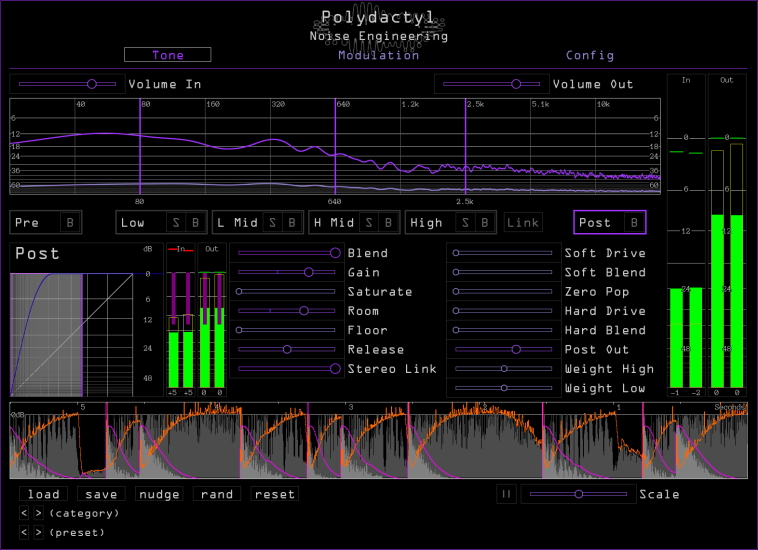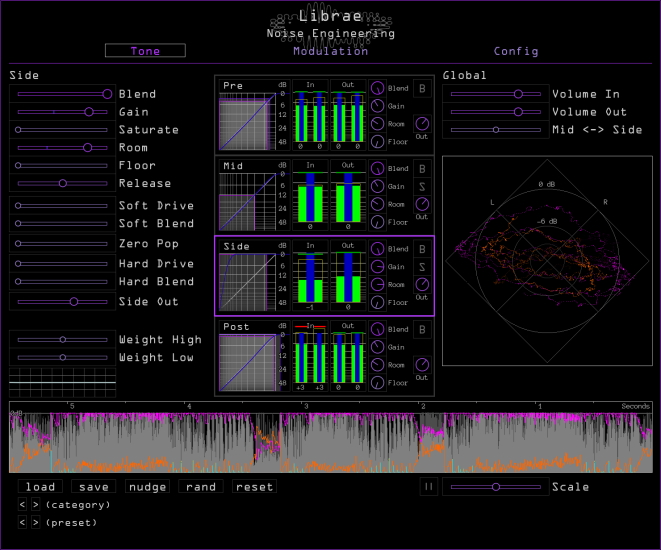Noise Engineering Polydactyl & Librae

Noise Engineering expands its software offerings by announcing availability of Polydactyl and Librae, two new dynamics-processing plug-ins presenting many flavors of compression, expansion, limiting, and distortion - Polydactyl being designed for anything from subtle mixing tasks to complete sonic destruction as a multiband processor, while Librae is made for mixing, mastering, sound design, and stereo-field experimentation - as of April 20…
“From the start, these plug-ins were intended for clean mastering, sound design, and coloration,” comments Noise Engineering Chief Plumber Adam Lange-Pearson, one of two software engineers behind Polydactyl and Librae. “While we worked on these, our chat threads were full for months with picky feedback about levels and sound quality, and heated ergonomics discussion,” he continues, concluding: “By the end, I am pretty sure we argued over every pixel in each meter at least once.”
Ostensibly, Polydactyl is a multiband processor inspired by over-the-top and aggressive techniques, yet it is designed to be versatile enough to be used in almost any mix. Featuring four adjustable bands - plus Pre and Post - to precisely sculpt the dynamics of audio tracks with separate per-section controls for Blend, Gain, Room, Floor, Release, and Stereo Link, the bands can be dialed in individually or the Link function can be utilized to quickly apply user settings across multiple bands (though turning Link off makes it simple to set each band as needed).
Though those controls break away from traditional dynamics-processing layouts, they simplify the workflow for dialing in subtle (or not-so-subtle) dynamics. Dedicated distortion controls such as Saturate, Soft Drive and Hard Drive (with associated Soft Blend and Hard Blend controls for clipping distortion), Zero Pop (for zero-crossing distortion), and output level are also included in each section, which can also be bypassed or soloed.
Saying that, the clean interface of Polydactyl provides a huge range of visual feedback. First and foremost, the frequency spectrum meter displays the output level across the audio spectrum and is interactive - click and drag the lines to adjust the band splits; select bands for further adjustment. Additionally, Polydactyl includes a scalable envelope display to show processing over time and global In and Out VU meters. Moreover, each stage also includes a static curve meter to demonstrate the compression and expansion applied to the signal, and In and Out VU meters.

Librae is a mid/side and stereo dynamics processor with separate controls for Pre, Mid, Side, and Post stages. Duly designed for transparency, Librae is made for master-bus applications, but the team behind the plug-in put a lot of thought into making it a capable tool for creative processing and sound design. Many of its controls are similar to those on Polydactyl. Put it this way: Librae also has separate per-stage controls for Blend, Gain, Saturate, Room, Floor, Release, and Stereo Link, plus distortion controls like Saturate, Soft Drive and Hard Drive (with dedicated Soft Blend and Hard Blend), Zero Pop, and output-level controls. Its Pre and Post stages also feature shelf-EQ weight controls to adjust how the plug-in’s dynamics processing responds to the incoming signal. Librae features a Global Mid < - > Side balance control for easy adjustment. Similarly, each section can also be bypassed or soloed.
It is easy to understand Librae, though, thanks to a detailed graphical interface featuring a goniometer displaying the correlation between the input channels and an envelope display showing processing over time. Each processing stage features a dedicated graphical display with a static curve meter to show the curve applied to the signal, In and Out VU meters, and a weighting graph to visualize the detector shelf EQ weighting (with adjustable Weight High and Weight Low) on the stage input.
In keeping with all Noise Engineering plug-ins, Polydactyl and Librae are designed for automation and each include an extensive internal modulation matrix with LFOs and step sequencers that can be routed to almost any parameter. Moreover, modulators have adjustable randomization for easy humanization.
Intuitive in use from first being opened, Polydactyl and Librae both come complete with a sizeable number of Noise Engineering-provided presets - ranging from subtle and transparent to aggressive and in-your-face - to kickstart anyone in need of inspiration. If more than that is needed then the rand (random) and nudge buttons (to generate and tweak patches in one click) are sure to get creative juices flowing.
Available as two new dynamics-processing plug-ins presenting many flavors of compression, expansion, and distortion, Polydactyl and Librae are ready to take up their positions in signal-processing toolkits the world over.
Polydactyl and Librae are available now in AAX, AU, and VST formats for $49.00 USD apiece, and also available as part of the Build Your Own Bundle (buy any three plug-ins and automatically get one for half price) - only from Noise Engineering.
 How to resolve AdBlock issue?
How to resolve AdBlock issue?